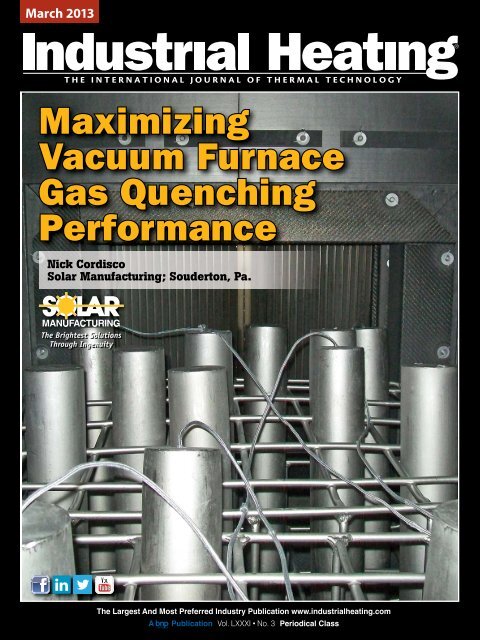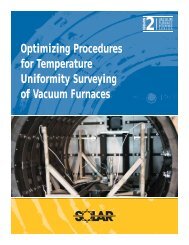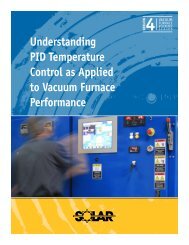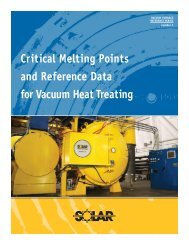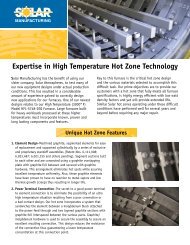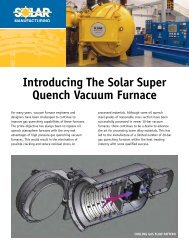Maximizing Vacuum Furnace Gas Quenching Performance - Solar ...
Maximizing Vacuum Furnace Gas Quenching Performance - Solar ...
Maximizing Vacuum Furnace Gas Quenching Performance - Solar ...
You also want an ePaper? Increase the reach of your titles
YUMPU automatically turns print PDFs into web optimized ePapers that Google loves.
March 2013<br />
<strong>Maximizing</strong><br />
<strong>Vacuum</strong> <strong>Furnace</strong><br />
<strong>Gas</strong> <strong>Quenching</strong><br />
<strong>Performance</strong><br />
Nick Cordisco<br />
<strong>Solar</strong> Manufacturing; Souderton, Pa.<br />
The Brightest Solutions<br />
Through Ingenuity<br />
The Largest And Most Preferred Industry Publication www.industrialheating.com<br />
A Publication Vol. LXXXI • No. 3 Periodical Class
FEATURE | <strong>Vacuum</strong>/ | Surface Treating<br />
<strong>Maximizing</strong> <strong>Vacuum</strong> <strong>Furnace</strong><br />
<strong>Gas</strong> <strong>Quenching</strong> <strong>Performance</strong><br />
Nick Cordisco – <strong>Solar</strong> Manufacturing; Souderton, Pa.<br />
Fig. 1. Test load<br />
used for data<br />
collection<br />
here are many critical factors<br />
that engineers must consider<br />
when designing a new, high-<br />
gas-quenching Tperformance<br />
vacuum furnace, including:<br />
• Proper fan design to achieve maximum<br />
gas flow<br />
• Creating a minimal flow-resistance<br />
path for the recirculating gas<br />
• Consideration of the types of cooling<br />
gases to be used<br />
• A method to optimize the cooling system’s<br />
available power<br />
Most vacuum furnaces are designed to<br />
operate at maximum pressure for a specific<br />
gas type (nitrogen, argon, helium, hydrogen).<br />
This approach sacrifices system performance<br />
at pressures lower than the optimal<br />
pressure as specified by the design.<br />
It also lengthens cycle time and creates<br />
extreme performance limitations when<br />
implementing other gases. To compensate<br />
for the change in gas density, quench<br />
pressure and/or fan speed decreases. Since<br />
using argon as well as nitrogen is often a<br />
requirement in many heat-treating facilities,<br />
these issues are a cause for concern.<br />
Synchronous Design Concept<br />
In order to overcome many of the disadvantages<br />
that exist on current vacuum<br />
furnaces, <strong>Solar</strong> has implemented a synchronous<br />
design concept in its new highpressure-quench<br />
furnace. Key components<br />
of this design include:<br />
• Utilizing a variable-frequency drive<br />
(VFD) to “over-speed” the cooling-fan<br />
motor<br />
• Selecting a specially designed motor<br />
that can withstand the “over-speed”<br />
conditions<br />
• Designing an appropriately sized fan to<br />
operate across the entire pressure range<br />
Comparing Synchronous to<br />
Conventional Design for Two <strong>Gas</strong>es<br />
As opposed to traditionally designed vacuum<br />
furnaces, the synchronous approach<br />
allows the cooling system of the furnace<br />
to operate at the high motor-speed range<br />
Temperature, ˚F<br />
2000<br />
1800<br />
Avg. HIQ-5748<br />
2000<br />
1900<br />
20-bar avg.<br />
1600<br />
Avg. SSQ-5748<br />
15-bar avg.<br />
1800<br />
HIQ-5748 control T/C<br />
10-bar avg.<br />
1400<br />
1200<br />
1000<br />
800<br />
600<br />
400<br />
200<br />
0<br />
SSQ-5748 control T/C<br />
1700<br />
1600<br />
1500<br />
1400<br />
1300<br />
1200<br />
1100<br />
1000<br />
6-bar avg.<br />
4-bar avg.<br />
2-bar avg.<br />
1 2 3 4 5 6 7 8 9 10 11 12 13 14 15 16 17 18 19 20 0 1 2 3 4 5 6 7 8 9 10<br />
Elapsed time, minutes<br />
Elapsed time, minutes<br />
Fig. 2. 10-bar comparison (average work temperature) –<br />
SSQ-5748 vs. HIQ-5748<br />
Temperature, ˚F<br />
Reprinted from Industrial Heating March 2013<br />
Fig. 3. SSQ-5748 average work temperature vs. time<br />
(varying pressure)
■ Featured in Industrial Heating March 2013<br />
using nitrogen and at a slightly reduced<br />
speed with argon while maintaining the<br />
same pressure. Full horsepower can be<br />
utilized because the operating speed is<br />
still above the synchronous motor speed.<br />
Table 1 is normalized to compare the relative<br />
performance of each system when using<br />
nitrogen and argon gas.<br />
Equating the relative performance of<br />
the two systems shows:<br />
• Nitrogen: 7,200/7,200 = 1<br />
The two systems provide equal relative<br />
cooling for nitrogen at this pressure.<br />
• Argon: 6,468/5,220 = 1.24<br />
This illustrates the improved relative<br />
cooling (24% better) when using argon<br />
in the synchronous system as compared<br />
to the conventional system.<br />
Applying the Synchronous Design<br />
to New 20-Bar <strong>Vacuum</strong> <strong>Furnace</strong><br />
The synchronous design with its VFD was<br />
recently incorporated into <strong>Solar</strong>’s newest<br />
20-bar Super Quench vacuum furnace<br />
(SSQ). This recently manufactured and<br />
installed system has gone through an extensive<br />
testing program to fully compare<br />
its performance to prior conventional designs.<br />
This furnace has a work zone that measures<br />
36 inches wide x 36 inches high x<br />
48 inches deep with a gas cooling system<br />
incorporating a 300-HP motor. The test<br />
load in Figure 1 was selected to represent<br />
a typical load for this size furnace and has<br />
been used on all tests and illustrations<br />
Table 1. Relative performance comparison – argon vs. nitrogen<br />
Table 2. Effect of pressure increases<br />
that follow. The test load incorporated:<br />
• 20 steel bars, each measuring 3 inches<br />
O.D. x 28 inches long<br />
• Six work baskets and one supporting<br />
grid<br />
• Total load weight of approximately<br />
1,300 pounds<br />
• Seven T/Cs throughout the load to<br />
measure the core temperature<br />
The cooling test procedure was as<br />
follows:<br />
• The same load was used for all tests.<br />
• Nitrogen was used as the cooling gas.<br />
• The load would be quenched from<br />
2000˚F.<br />
• The quench pressure was varied to obtain<br />
performance data.<br />
• Quench pressures were 2, 4, 6, 10, 15<br />
and 20 bar.<br />
Conventional design<br />
Synchronous design<br />
Nitrogen Argon Nitrogen Argon<br />
Pressure (P) - bar (a) 2 1.45 2 2<br />
Density (r) - lb./cu.ft. 0.148 0.148 0.148 0.204<br />
Speed (N) - RPM 3,600 3,600 3,600 3,234<br />
Product of P x N 7,200 5,220 7,200 6,468<br />
Relative HP used, % 100 100 100 100<br />
<strong>Gas</strong> backfill pressure Frequency (Hz) Motor speed (RPM) Motor current (amps)<br />
2 bar 113 3,291 325<br />
4 bar 90 2,628 334<br />
6 bar 77 2,261 327<br />
10 bar 63 1,850 314<br />
Comparison of Conventional 10-Bar<br />
<strong>Furnace</strong> and Synchronous Design<br />
Cooling at 10 Bar<br />
In order to demonstrate the improved<br />
cooling of the newly designed 20-bar<br />
furnace, <strong>Solar</strong> proceeded with a test in a<br />
10-bar furnace cooling at 10-bar pressure<br />
using the same load and compared that<br />
with a test from the 20-bar furnace cooling<br />
at 10 bar. The 10-bar conventional<br />
design is identified as the HIQ-5748 furnace,<br />
while the 20-bar furnace is identified<br />
as the SSQ-5748 furnace. Figure 2<br />
illustrates the signifi cant improvement of<br />
the synchronous design versus the conventional<br />
design.<br />
The synchronous design cooling at<br />
4-bar backfi ll pressure produced the same<br />
cooling performance as the conventional<br />
design cooling at 10-bar backfi ll pressure.<br />
That means the same results were<br />
achieved using 60% less gas.<br />
Table 2 shows the unique varying components<br />
of the synchronous design as pressure<br />
increases.<br />
Testing SSQ-5748 at Various<br />
<strong>Gas</strong> Pressures<br />
The next series of tests involved processing<br />
the same test load across various gas pressures<br />
ranging from 2 to 20 bar (Figure 3).<br />
This illustrated the excellent cooling rates<br />
that can be achieved using the synchronous<br />
design.<br />
These results also demonstrated cooling<br />
rates that could be applied to certain oilquench-grade<br />
materials to achieve desired<br />
properties that were previously thought<br />
not possible with gas quenching. Further<br />
studies are now under way to establish<br />
which materials of a given cross-section<br />
could be processed in this style furnace.<br />
Conclusions<br />
Based on this comprehensive test data,<br />
the resulting conclusions are:<br />
• Incorporating a VFD into a gasquenching<br />
system allows for excellent<br />
versatility regarding gas cooling at different<br />
pressures and when using different<br />
gas types.<br />
• Operating at or above synchronous<br />
motor speed maximizes system performance.<br />
• The synchronous design concept allows<br />
using the largest possible fan to maximize<br />
efficiency across the entire pressure<br />
range.<br />
• The SSQ furnace will allow gas<br />
quenching to replace oil quenching on<br />
certain materials, thus greatly improving<br />
part stability and any need for further<br />
post-process operations. IH<br />
For more information: Contact Nick<br />
Cordisco, electrical engineer, <strong>Solar</strong><br />
Manufacturing Inc., 1983 Clearview Road,<br />
Souderton, PA 18964; tel: 267-384-5040;<br />
fax: 267-384-5060; e-mail: nick@solarmfg.<br />
com; web: www.solarmfg.com
When “just good enough”<br />
isn’t good enough for you.<br />
Experience<br />
Value<br />
Service<br />
New 20 bar high-pressure<br />
quench vacuum furnace<br />
Model HFL 5748-20IQ<br />
Versatility<br />
INGENUITY<br />
Integrity<br />
Go beyond a “make do” furnace with creative design from <strong>Solar</strong> Manufacturing.<br />
Whether your vacuum processing challenge is ordinary or extraordinary, our innovative<br />
engineering opens a new world of possibilities. Unbounded thinking paired with<br />
deep experience creates unique solutions to efficiently meet your needs.<br />
Learn how our game-changing insight can take your heat treating business<br />
to the next level, call 267.384.5040 or visit www.solarmfg.com.<br />
The Brightest Solutions<br />
Through Ingenuity<br />
PROUDLY MADE IN THE USA


